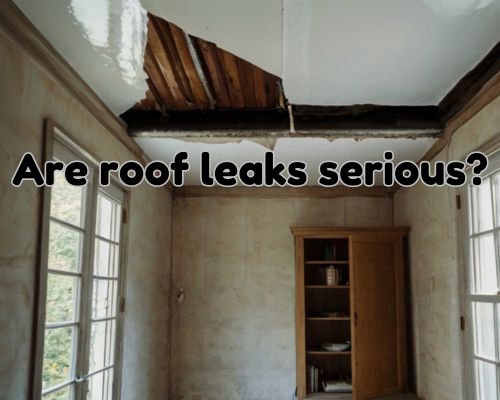Discovering a roof leak can be unsettling. It leaves you with the nagging worry of what damage might be hidden above. Roof leaks are indeed serious concerns that homeowners should not overlook. They have the potential to cause significant structural damage, health risks from mold, and even electrical hazards. By paying attention to the signs, such as water stains or peeling paint, you can quickly identify and address the root of the problem.

As a homeowner, dealing with a leaky roof requires swift action to prevent costly repercussions. The longer you delay repair, the more likely you are to face issues like mold. Mold can spread rapidly, complicating the integrity and safety of your home. Leaks don’t just affect the visible surfaces; moisture can spread through insulation and into other parts of your structure.
CJ Commercial Roofing NJ highlights that: A proactive approach, involving regular roof inspections, is essential in mitigating the risks associated with roof leaks. Even if your roof is relatively new, natural aging of materials can render any roof susceptible to issues. Understanding the common causes of leaks and how to fix them is crucial in safeguarding your investment and maintaining the sanctuary that your home provides.
Understanding Roof Leaks
Roof leaks can cause significant damage if not addressed quickly. Recognizing the typical causes, visible signs, and the necessity of routine inspections can help protect your home and wallet.
Identifying Common Causes
Several factors can lead to roof leaks. Damaged or missing shingles are frequent culprits, as they can allow water to penetrate the roof surface. Flashing, which seals the joints in your roof, can also fail due to wear and tear, leading to leaks.
Roof penetrations such as vents or chimneys are other common areas where leaks originate, often due to poor sealing. Meanwhile, clogged gutters can cause water to overflow, directing it into areas where it can seep beneath the shingles. Regular maintenance in these areas can prevent many leaks.
Signs and Consequences
Spotting the signs of a roof leak is crucial for preventing major issues. Water stains on walls or ceilings, mold growth, and blistering paint are telltale signs indicating potential water intrusion. Unchecked, these can lead to severe problems, including structural damage and health risks due to mold exposure.
Roof valleys, where two roof slopes meet, can also show signs of leakage if debris is allowed to accumulate. Timely attention to these signs ensures minimal repair costs and prevents extensive damage.
The Importance of Roof Inspections
Regular roof inspections are vital to catch problems before they become significant. Professional inspections help identify wear and tear on materials like shingles and flashing before leaks start. Ensuring roof penetrations are properly sealed and gutters are clear is essential.
Annual inspections should ideally align with seasonal changes to ensure your roof is ready to withstand varying weather conditions. By staying proactive, you safeguard your home against unexpected leaks and prolong the lifespan of your roofing system.
Professional Intervention
Professional intervention is crucial when addressing roof leaks to ensure effective repairs and prevent future issues. This section covers key considerations such as determining when to contact a roofing contractor, options for repair or replacement, and essential waterproofing and maintenance practices.
When to Contact a Roofing Contractor
Contact a roofing contractor like CJ Commercial Roofing NJ when signs of major roof damage appear, including large leaks, extensive mold growth, or structural concerns. These issues often need expertise that DIY efforts can’t provide. Look for indicators like damaged roof flashing, missing or replaced shingles, or significant water intrusion around vent pipes and roof vents.
Professional roofers are skilled in identifying hidden damage that may not be immediately visible. Selecting a knowledgeable contractor is essential, as they can assess the full extent of the damage and suggest appropriate solutions. Reliable professionals help ensure your roof’s integrity and prevent costly future repairs.
Repair vs. Replacement Options
Deciding between repair and replacement depends on the damage’s severity and the roof’s age. If issues like small leaks or a few damaged shingles are present, repair might suffice.
Alternatively, replacement becomes necessary when there’s widespread damage, such as warping in commercial roofing structures or compromised roof flashing.
A professional roofer will evaluate the roof’s lifespan and the cost-effectiveness of either option. They might recommend regular roof maintenance to delay or avoid replacement. Weighing repair versus replacement with an expert provides clarity and direction based on your roof’s specific needs and budget.
Waterproofing and Preventive Measures
Effective waterproofing extends your roof’s life. It protects it from future leaks and mold growth.
Professional contractors apply specialized roofing nails and sealants around roof vents, joints, and seams. This ensures a tight seal against water penetration.
Including drip edges and ensuring proper drainage help divert water away from the home.
Regular inspections, scheduled by professional roofers, help identify potential vulnerabilities. Keeping gutters clear and checking roof integrity after harsh weather are simple preventive measures.
An expert can also advise on the latest waterproofing technologies. They can recommend treatments best suited for your roofing materials. This ensures lasting durability and protection.